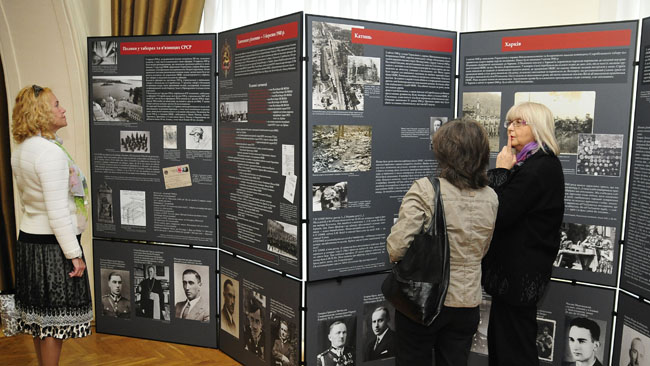On the similarity of Nazism and communism
Kyiv hosts exhibit “Extermination of Polish Elites: Katyn, AB-Aktion”
An exhibit, “Extermination of Polish Elites: Katyn, AB-Aktion,” has been opened at the National Museum of Ukraine’s History. This exposition is the result of cooperation between the Ukrainian and Polish institutes of national remembrance to mark the 75th anniversary of the Katyn tragedy.
The exposition comprises stands that chronicle events. They illustrate the German invasion of the Soviet Union and Poland, life during the occupation, a criminal decision of the VKP(b) CC Politburo on the Katyn execution and the attempts to falsify this tragedy. The stands also show statistical data, letter extracts, photographs, and stories of the killed individuals and families.
“This exposition is a history of the deaths of tens of thousands of representatives of the Polish elite: professors, officials, doctors, etc. It is special in that it presents the destinies of concrete people,” says Dr. Lukasz Kaminski, director of the Polish Institute of National Remembrance. In his words, not to allow the Soviet Union to come back, we must see to it that “the memory of the communist regime’s crimes is alive.” He also noted that, unlike the Nazi criminals, the Stalinist regime’s lawbreakers were never punished.
According to Volodymyr Viatrovych, director of the Ukrainian Institute of National Remembrance, this exhibit shows very well the “likeness of the two criminal – communist and Nazi – regimes: “They were both aimed at wiping out the true elite of society. The USSR and Germany also applied identical methods, such as imprisonment, deportation, and mass-scale killings.
Mr. Viatrovych also recalled that the Verkhovna Rada of Ukraine passed a law on April 9 this year, which “puts an equal sign between the two criminal regimes.” But, in his opinion, it is not enough: the law must start a real condemnation of totalitarian regimes.
“Our country was one of the first victims of communism, but its way of decommunization was the longest. I am still convinced that the parliamentary decision may be the ‘last straw’ that will take the case to an international tribunal – the long-awaited anticommunist Nuremberg,” Viatrovych emphasized.
The Ambassador Extraordinary and Plenipotentiary of the Polish Republic to Ukraine, Henryk Litwin, attended the opening ceremony. In his view, “true decommunization means to stop ideologizing history, open all archives, and ensure a complete freedom of research.” He also stressed that “Poland saw regaining full independence as equivalent to regaining the truth about Katyn.”
According to Ukraine’s Minister for Education and Science, Serhii Kvit, the West still considers Stalin a “great ally” in the war against Hitler. But the minister thinks this approach must be changed altogether. “While there were two totalitarian states before World War Two, there was only one left after it. And the current phenomenon of Putinism results from the fact that there was no decommunization in either the Soviet Union or Russia,” the minister pointed out.
The Polish and Ukrainian institutes of national remembrance are planning to form a joint task force of historians to study the 1939-47 Polish-Ukrainian conflict. In the words of Viatrovych, it is necessary to discuss a lot of ticklish and disputable questions. One of them is harassment of the Ukrainians who were citizens of the Second Polish Republic, for those repressions were one of the factors that radicalized Ukrainian political forces. Given a proper study, this history will bring closer, not disunite, the Ukrainians and the Poles. The cooperation of Polish and Ukrainian historians is supposed to result in further exhibits, particularly, on the crimes committed on Ukraine’s territory and on the persecution of Ukrainian elites.
The Katyn tragedy and Action AB were the most horrible instances of repressive actions taken in 1939-41 on the territory of Poland by the Soviet and German occupational authorities, respectively. In the spring of 1940, on the orders of Stalin and Beria, almost 22,000 people were massacred in the forest near the village of Katyn (now Smolensk oblast, Russia), Kharkiv, Kalinin, and prison camps of western Ukraine and Belarus. At the same time, on the Wehrmacht-occupied Polish territories, the Nazis conducted the so-called AB-Aktion (Ausserordentliche Befriedungsaktion – the German for “Extraordinary Operation of Pacification”), in which about 6,000 Poles were shot dead. Together with the Poles who died during similar operations in other lands seized by the Reich, the total number of the killed reaches 50,000.
Newspaper output №:
№33, (2015)Section
Society





